Embracing the Summit: The Essential Kilimanjaro Trekking Gear For Beginners
At the foot of the towering Mount Kilimanjaro, the air buzzes with anticipation and the spirit of adventure. Here at Kilimanjaro Centre for Trekking and Ecotourism (KCTE), we know that the journey to the roof of Africa is not just about endurance and strength, but also about preparation. Especially for beginners, knowing what gear to pack is the first step toward a successful and memorable climb. In this guide, we'll walk you through the essential Kilimanjaro trekking gear for beginners, ensuring you are well-equipped to face the majestic Mount Kilimanjaro.
Why the Right Gear Matters
Embarking on a trek to Kilimanjaro is no ordinary feat. At 5,895 meters, it's the highest mountain in Africa and offers diverse climatic conditions as you ascend. The right gear will not only enhance your comfort but also your safety. Whether battling the rainforest's moisture, the desert's chill, or the summit's icy winds, each piece of your gear plays a pivotal role in your journey.
Core Trekking Gear: Your Kilimanjaro Checklist
H1: Clothing for Layering
Base Layer:
Start with a moisture-wicking base layer. It keeps you dry by drawing sweat away from your skin, crucial in both cold and warm temperatures.
Insulation Layer:
An insulated layer retains body heat. Fleece jackets are ideal as they are lightweight yet warm, and easy to pack.
Outer Layer:
A waterproof and windproof jacket is essential to shield you from the elements. Look for breathable materials to prevent overheating.
H2: Footwear – The Foundation of Every Step
Hiking Boots:
Invest in a good pair of waterproof hiking boots with ample ankle support and a grip that can handle rocky and slippery terrains.
Trekking Socks:
Breathable, moisture-wicking socks are just as important as the boots you wear. Consider bringing a few pairs to ensure dry, comfortable feet throughout your trek.
H2: Headgear and Handwear
Hat and Neck Scarf:
Protect yourself from the sun's UV rays with a wide-brimmed hat or a cap. A neck scarf or a balaclava can provide additional protection against the cold and wind.
Gloves:
Waterproof, insulated gloves are crucial, especially as you near the summit where temperatures can drop significantly.
H2: Backpack Essentials
Day Pack:
A sturdy, comfortable backpack (30-40 liters) is ideal for carrying your daily essentials. Look for one with multiple compartments and water-resistant material.
Hydration System:
Staying hydrated is key. A hydration bladder or a couple of water bottles should suffice, but ensure they are durable and easy to use.
Additional Gear for Your Comfort and Safety
H2: Sleeping Equipment
A good night's sleep is vital. A four-season sleeping bag and an insulated sleeping pad will help you rest comfortably, recharging you for the next day's climb.
H2: Trekking Poles
Trekking poles reduce the impact on your knees and help maintain balance on uneven terrain. They can be particularly helpful during descents.
H2: Miscellaneous Must-Haves
Headlamp:
With early morning starts, a headlamp is indispensable for seeing in the dark. Ensure it's fitted with strong batteries.
Sunglasses and Sunscreen:
Protect your eyes and skin from harsh UV rays, which are more intense at higher elevations.
First Aid Kit:
Include basics like bandages, antiseptic wipes, and blister treatments, as well as any personal medications.
High-Energy Snacks:
Nuts, chocolate, and energy bars can offer quick, satisfying boosts during your trek.
Preparing for the Journey
H2: Acclimatization and Training
Preparing your body for Kilimanjaro is as crucial as packing the right gear. Focus on cardiovascular fitness, strength training, and altitude acclimatization if possible. Remember, the better your fitness, the more you'll enjoy the trek.
H2: Choosing the Right Tour Operator
Here at Kilimanjaro Centre for Trekking and Ecotourism (KCTE), we specialize in providing tailored experiences that cater to the needs of beginners and experienced climbers alike. Choosing a knowledgeable and experienced tour operator is key to a safe and enjoyable climb.
In Summary
Embarking on a trek to Mount Kilimanjaro is a life-changing experience. With the right gear, preparation, and support from a dedicated team like ours at KCTE, you're setting yourself up for success on the African peak.
FAQs
Q1: What is the best time of year to climb Kilimanjaro?
A: The best times are during the dry seasons: January to March and June to October.
Q2: How long does it take to climb Kilimanjaro?
A: It typically takes about 5 to 9 days, depending on the route and your pace.
Q3: Do I need a visa to enter Tanzania for a Kilimanjaro trek?
A: Yes, most travelers will need a visa, which you can get upon arrival or online before you travel.
Q4: Can beginners really climb Kilimanjaro?
A: Absolutely! With the right preparation, gear, and guidance, beginners can successfully summit.
Feeling inspired to tackle Kilimanjaro? Book your climb with Kilimanjaro Centre for Trekking and Ecotourism (KCTE) today and take the first step towards an unforgettable adventure. We're here to guide you each step of the way!




